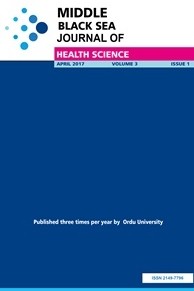Evaluation of Gross Alpha and Beta Radioactivity Concentrations in Tooth Samples
Teeth, gross alpha, gross beta, radioactivity, radiation, Teeth, gross alpha, gross beta, radioactivity, radiation
Evaluation of Gross Alpha and Beta Radioactivity Concentrations in Tooth Samples
teeth, gross alpha, gross beta, radioactivity, radiation,
___
- 1. Aghamiri SMR, Ghorbani Z, Darafsheh A, Torabzadeh H, Fathivand AA, Minuchehr A, et al. 226Ra concentration in the teeth of habitants of areas with high level of natural radioactivity in Ramsar. J Environ Radioact. 2006;89(3):212-218.
- 2. White SC, Pharoah MJ. Oral Radiology principals and ınterpretation. 7 th ed. Mosby, Canada, 2014. p. 1-28.
- 3. Cinelli G, Tollefsen T, Bossew P, Gruber V, Bogucarskis K, De Felice L, et al. Digital version of the European Atlas of natural radiation. J Environ Radioact. 2019;196:240-252.
- 4. Sogut O, Aydin MF, Kucukonder E, Zorer OS, Dogru M. Measurement of gross alpha and gross beta activity concentrations in human tooth. J Environ Radioact. 2010;101(3):226-229.
- 5. Taskin H, Kobya Y, Tokgoz M, Bassari A, Yesilkanat CM. Biomonitoring of trace elements and gross alpha/ beta radioactivity levels in human teeth: A case study from Istanbul, Turkey. Microchemical Journal. 2018;141:458-465.
- 6. Clemente GF, Renzetti A, Santori G, Steinhäusler F, Pohl-Ruling J. Relationship between the 210Pb content of teeth and exposure to Rn and Rn daughters. Health Phys. 1984;47(2):253-262.
- 7. Delibacak S, Ongun AR. Influence of treated sewage sludge applications on corn and second crop wheat yield and some soil properties of sandy loam soil. Fresen Environ Bull. 2016;25(1):43-54.
- 8. Kir I, Erdogan M, Engin MS, Cay S. Trace metals in sediment, water and their bioaccumalation in Carp (Cyprinus Carpio L., 1758) samples, captured from the Karacaoren (I) Dam Lake, Turkey. Fresen Environ Bull. 2016;25(9):3557-3562.
- 9. Beir VI. Report of the Committee on the Biological effects of Ionizing Radiation, National. Research, Council. 1999.
- 10. Brown CJ, Chenery SR, Smith B, Mason C, Tomkins A, Roberts GJ, et al. Environmental influences on the trace element content of teeth—implications for disease and nutritional status. Arch Oral Biol. 2004;49(9):705-717.
- 11. Corbacho JA, Zapata-García D, Montaña M, Fons J, Camacho A, Guillén J, et al. Selection of the appropriate radionuclide source for the efficiency calibration in methods of determining gross alpha activity in water. J Environ Radioact 2016;151:22-7.
- 12. Butler FE. Strontium-90 in human teeth. Natur. 1961;11(189):848-849.
- 13. Yamamoto M, Hinoide M, Ohkubo Y, Ueno K. Concentration of 226Ra in human teeth. Health Phys. 1994;67(5):535-540.
- 14. Kulev YD, Polikarpov GG, Prigodey EV, Assimakopoulos PA. Strontium-90 concentrations in human teeth in South Ukraine, 5 years after the Chernobyl accident. Sci Total Environ. 1994;155(3):215-219.
- 15. Baltas H, Sirin M, Senel F, Devran F. Determination of natural radionuclides and some metal concentrations in human tooth samples in the Rize province, Turkey Int J Environ Health Res. 2019; 31(1):20-33.
- 16. Kavun Y, Boztosun I, Ðapo H, Maras I, Segebade C. Determination of the Sr/Ca ratio of tooth samples by photoactivation analysis in Southern Turkey. Radiochimica Acta. 2018;106(9):759-768.
- 17. Ugur A, Sahan H, Sahan M, Yegingil Z, Gorur S. Investigation of the relation between environmental radioactivity and radioactivity in human teeth who lives in this environment. Fizika (Baku). 2010;16:537-540.
- 18. Mangano JJ, Gould JM, Sternglass EJ, Shermand JD, McDonnelle W. An unexpected rise in strontium-90 in US deciduous teeth in the 1990s. Sci Total Environ. 2003;317 (1-3):37-51.
- 19. Dogru M, Kulahci F. Iso-radioactivity curves of the water of the Hazar Lake, Elazig, Turkey. J Radioanal Nucl Chem. 2004;260(3):557-562. 20. Zorer OS, Ceylan H, Dogru M. Assessment of some trace heavy metals and radioactivity concentration in water of Bendimahi River Basin (Van, Turkey). Environ Monit Assess. 2008;147(1-3),183-90.
- 21. Zorer OS, Ceylan H, Dogru M. Determination of heavy metals and comparison to gross radioactivity concentration in soil and sediment samples of the Bendimahi River Basin (Van, Turkey). Water, air, and Soil Pollution. 2009;196:75-87.
- 22. Zorer OS, Ceylan H, Dogru M. Gross alpha and beta radioactivity concentration in water, soil and sediment of the Bendimahi River and Van Lake (Turkey). Environ Monit Assess. 2009;148(1-4):39-46.
- 23. Rothe WE. Gross alpha radioactivity of human bones and teeth. Radiol Health Data Rep. 1966;7(3):204-205.
- 24. Dewit T, Clulow V, Jackson JS, Mitchel REJ. Uranium and uranium decay series radionuclide dynamics in bone of rats following chronic uranium ore dust inhalation. Health Phys. 2001;81(5):502-513.
- 25. Wrenn ME, Durbin PW, Howard B, Lipsztein J, Rundo J, Still ET, et al. Metabolism of ingested U and Ra. Health Phys. 1985;48(5):601-633.
- 26. Penna-Franca E. Review of Brazilian investigations in areas of high natural radioactivity part II: internal exposure and cytogenetic survey. In: Proceedings of the International Symposium on Areas of High Natural Radioactivity, Pocosde caldas, Brazil, 1977; 29–48
- Yayın Aralığı: Yılda 4 Sayı
- Başlangıç: 2015
- Yayıncı: Ordu Üniversitesi
Estimating Height and Body Weight Using Foot Measurements
Fournier’s Gangrene: Our Clinical Experience and Outcomes
İbrahim YAZICI, Erdal BENLİ, Abullah ÇIRAKOĞLU, Ahmet YÜCE, Nurullah KADİM, Mevlüt KELEŞ
Ömer Faruk ŞAHİN, Mehmet Semih ÇAKIR, Muhammet Teoman KARAKURT, Veysel ANTAR
An Analysis of Youtube Videos on the Topics of Coronavirus and Dentistry
Ayça KURT, Tuğba SERİN KALAY, Elif KİBAROĞLU
YouTube as an educational resource in neurosurgery
Abdussamed VURAL, İskender AKSOY, Mehmet EKİZ
Seda KESKİN, Deha Denizhan KESKİN
Analysis of Forensic Geriatric Patients Admitted to Emergency Department
